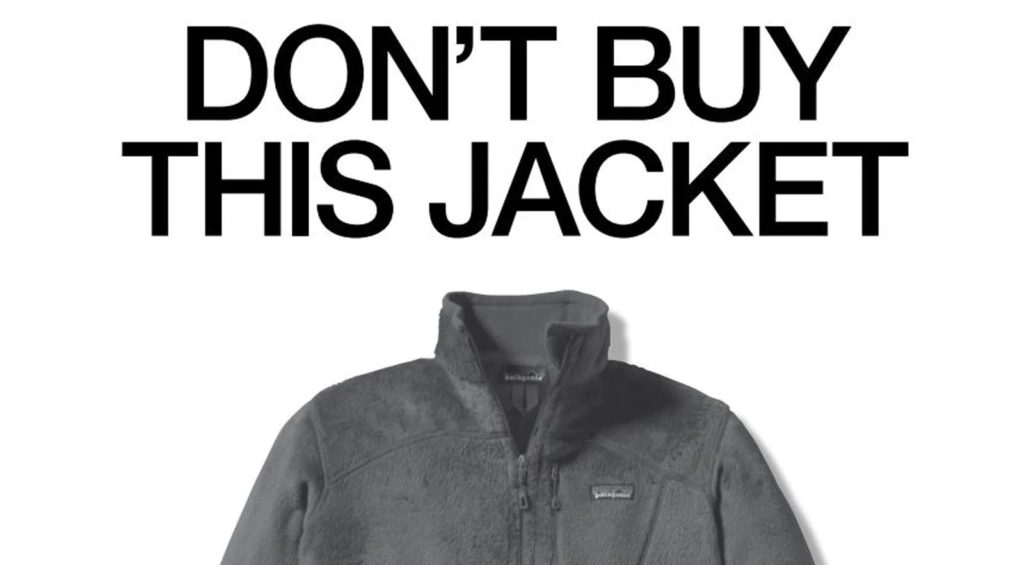In 2011, Patagonia made an unusual advertising campaign.
They told people the opposite of what a clothing brand wants customers to do.
“Don’t buy this jacket.”
And you know the best part?
They published it on Black Friday.
So imagine this.
You open a newspaper that day and see pages of ads from different brands.
Everybody tells you about their offers and why you should buy.
But then on the next page, you see this ad.

It’d catch your attention, right?
Well, it did.
People stopped and read the rest of the ad.
It was about the environmental impact of fast fashion and consumerism.
And encouraged people to recycle, reuse and repair clothes.
The campaign became a big success.
It positioned Patagonia as a company that prioritizes sustainability.
And people forgot all the ads they saw on that Black Friday, but remembered Patagonia’s and told it to their friends.
Even though the headline said don’t buy; Patagonia’s sales increased by 30%.
The Tyranny of The Salient
Now, we all know our minds pay attention to what’s salient.
If you see a red apple in a basket full of lemons, the apple gets your attention.
And Patagonia’s bold campaign proved its power.
But sometimes, this becomes a problem.
Because when we pay more attention to what’s noticeable —whether an object, trait, or event— we ignore less prominent but more relevant ones.
And this is called salience bias. It is common in daily life.
Salience Bias Examples From Daily Life
- Shiny features/traits: We focus on shiny features and overlook weaknesses. A Lamborghini is impressive. Until you find out its insurance and gas costs. It also happens with people. So managers hire candidates with salient traits and neglect important ones (e.g. high charisma, low integrity).
- Wrong risk assessments: Commercial air travel is statistically 1,000+ times safer than driving a car. But people are more afraid of flights as plane crashes are more salient. Another example is cybersecurity. Companies are usually ready for external cyberattacks and overlook less salient risks coming from employees — like inadvertent mistakes or leaks.
- Attention-grabbing policies: People vote for politicians who have strong stances on salient issues. But they overlook other important policies that might negatively impact them.

As with any cognitive bias, awareness goes a long way to avoiding it.
Then you can also take advantage of it — like Patagonia.
Let’s see how.
How to Avoid (And Benefit From) Salience Bias:
1. See the whole picture
You know what they say.
“If it seems too good to be true, it probably is.”
It happens often with investment opportunities and business deals.
An attractive point can make you ignore everything else.
Like a good price but unfavorable terms.
So whenever there is a piece of information, feature, or trait that gets all your attention; stop and take a step back.
Try to see the whole picture.
And take it through a negative frame.
What are the important but less visible points you are not considering?
Sometimes it’ll be a genuinely good opportunity.
But build your opinion only after you have considered all relevant information.
2. Solve hidden problems
People like obvious problems.
Competitors, the state of the economy, resources…
Because it reduces uncertainty in their minds.
And gives something to blame.
Yes, they have an impact.
But they are out of our control.
So instead of blaming noticeable external issues, look for hidden problems that are under your control.
Like what?
Like finding creative solutions.
Or building a better product.
Or having the courage to try something new.
When everybody is looking for something to blame, solve hidden problems to gain an edge.
3. Differentiate
We live in a noisy, crowded world.
Every product is a commodity.
The only way to get attention is differentiation.
In his book On Advertising, David Ogilvy explains how his agency differentiated SAAB in the Norwegian car market.
And without changing anything about the car.
“In Norway, the SAAB car had no measurable profile. We positioned it as a car for winter. Three years later it was voted the best car for Norwegian winters.”
So a simple frame in people’s minds was enough to differentiate SAAB from dozens of car brands.
And that’s the point many people miss.
The differentiation can happen in the mind.
A car is a car.
And a jacket is a jacket.
But when you position it right in people’s minds, it becomes salient.
So give people unique frames to describe your product or business to become unforgettable.
–
Enjoyed this article?
Then you’ll love the How Brands Win Newsletter.
Get the “7 Positioning Sins That Cost B2B Brands Millions” guide when you join. It’s free.
